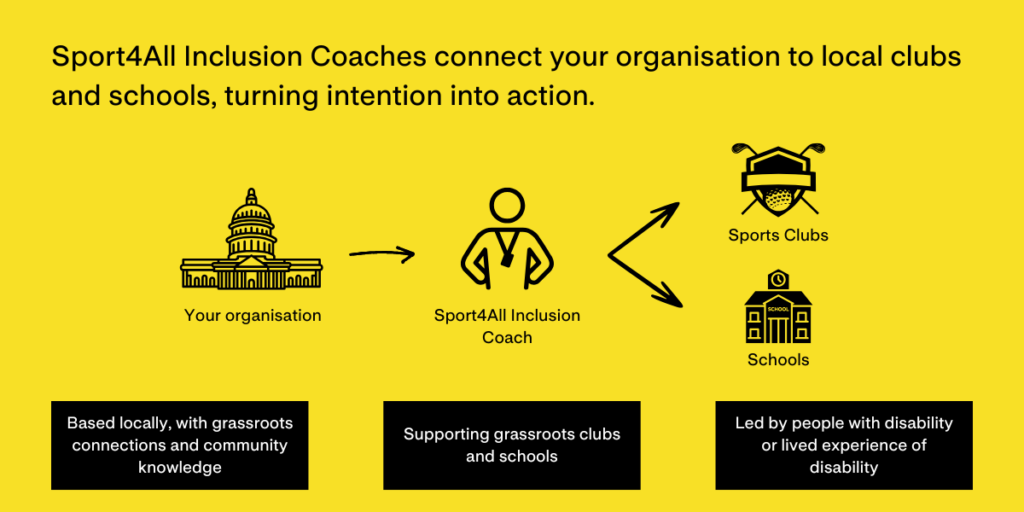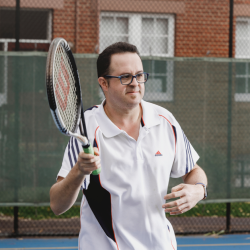What inclusion really looks like in community sport
Small actions, everyday awareness, and the culture we create together
Inclusion isn’t an initiative - it’s a culture
Across community sport, there’s a growing will to be more inclusive. Clubs want to open their doors wider, welcome new members, and remove barriers. But between intention and action, there’s often uncertainty, Where do we start? What if we get it wrong? What does inclusion actually look like on the ground and for a club like ours?
The truth is, most clubs don’t need to overhaul their facilities or build complex strategies to foster inclusion in grassroots sport. What they need is awareness, and a willingness to ask, learn, and shift the way things have always been done.
Small details, big impact!
Inclusion begins with the details we often overlook. A bathroom used as a storage room. A door that’s too heavy to open independently. A bar or canteen counter too high for someone in a wheelchair. A team post written in language that leaves some people out.
These aren’t dramatic failures of design or intent, they’re just common oversights. But they add up. And for someone with a disability, they can be the difference between showing up or staying away.
The reality is, most barriers can be fixed, and often with little to no cost. What matters is whether we see them. And for many clubs, it takes someone pointing them out to realise they were ever there in the first place.
Checkout the below video to see what these small changes can look like in action.
Sport4All would like to acknowledge the traditional custodians of the land on which we all live, work and travel upon. We pay our respects to elders past, present and emerging, and acknowledge and respect the connection that first nations peoples have to the sea, the sky and the land.
We acknowledge any and all first nations peoples involved in making the following videos, as well as those who are viewing it.
[Oliver] – I think the most important thing for me, when it comes to inclusion within sporting clubs is you’ve got to have an open mind.
[Maria] – While I ended up, uh, competing as an athlete, I actually started as an official. I’ve been a club committee member, I’ve been a junior team manager. People may have all sorts of things that they want to do within the club. Don’t make assumptions about what people can and can’t do.
[Jeremy] – At Sport4All our purpose is to help people with disability have choice control in sport in their local communities. So our inclusion coaches are, uh, working with those local clubs and the schools in those communities that they’re at to help them build their confidence and capability to get people with disabilities into their club across all roles and also letting clubs recognise the opportunity that it’s not just about playing sport. There’s so many opportunities in sport for people with disability to get involved. Sporting clubs are the vehicles which will enable these people to get involved in their local community.
[Nathan] – I’ve been involved in disability sports since I was a teenager through playing coaching and through work implementing inclusion initiatives. Sport has given me the opportunity to work on myself as a person. It’s given me the confidence to go into the workforce.
[Jeremy] – Something that’s really unique about our programme is our people and I think the inclusion coach and who they are. A person with disability who’s involved in sport, who comes from the community that they work within, they bring that experience into the role that they do.
[Oliver] – The number one fear was what if someone with a disability comes along to play and they get hurt? I said, yeah, that’s an absolutely fear and, uh, something to feel worried about. But you could argue that a typically developed able bodied player could also get hurt. Everyone should have the opportunity to get hurt.
[Oliver] – That’s basically what the point of this discussion is. Everyone should be allowed to get hurt playing sport. You can have all the physical hardware of accessibility, but if your mind is closed off, then we’re going to have a lot more struggle to open your club up to inclusion.
Beyond Access: What it means to feel welcome
Of course, inclusion in grassroots sport isn’t just about physical access. It’s also about how a club feels. Does someone feel seen when they walk in? Is the tone of communication open and respectful? Are there opportunities to participate fully, not just be present, but to belong?
Creating an inclusive club culture doesn’t require training manuals or big policies (though those help too). It starts with curiosity. With asking questions like:
- Have we ever asked what people might need to feel included here?
- Have we assumed “everyone can just figure it out”?
- Do we model a culture where people feel safe to speak up?
When inclusion is baked into how we interact, not just how we build, it becomes part of the club’s DNA.
Real voices, everyday insight
We strongly believe that lived experience matters! The people who know what makes a space inclusive, or exclusive, are often those who’ve had to navigate both.
Their insights offer a broader lens on what inclusion looks like in action, not just in facilities, but in club culture. Whether it’s a team leader creating space for honest conversations, or a coach adjusting their approach to better support all players, these stories show how values translate into everyday decisions. This is what inclusion in grassroots sport can feel like, when it’s built into the culture from the ground up.
Check out the video below to see how inclusive culture takes shape at local clubs, through leadership, conversation, and everyday choices.
Sport4All would like to acknowledge the traditional custodians of the land on which we all live, work and travel upon. We pay our respects to elders past, present and emerging, and acknowledge and respect the connection that first nations peoples have to the sea, the sky and the land.
We acknowledge any and all first nations peoples involved in making the following videos, as well as those who are viewing it.
[Oliver] – Often at local sporting clubs, the entrance and exits aren’t accessible. The easiest way you could change, uh, this is potentially offering a sliding door option as opposed to a standard open and closed door.
[Maria] – For me to get myself and my staff to those competition venues. Sometimes I found a volunteer from the club that was going there, sometimes there wasn’t somebody and I got a maxi taxi. But it was always easier when there was somebody.
[Fiona] – The attitudes and the culture are an important part of the barriers as well because, you know, if you’re not going to, if they’re going to say no, this is the way that we swim and this is the only way that we do it. It makes it really hard to then go, well, I can’t do it that way so I’m not going to participate. It’s changing that mindset.
[Nathan] -If you want to invite people with invisible disabilities in your club, having staff trained in the Songplay scheme can help people feel more comfortable in a sporting environment.
[Maria] – I didn’t set out to be a high performance athlete, that just happened. I started in sport because I wanted the community that I saw.
[Jenny] – So some of the things that I like to talk about when I’m out meeting SSOs and clubs and associations is some of the small things that they can do straight away to start being a bit more inclusive. Things like letting people know on their website the accessibility of their club so that anyone coming, be it a player or a spectator, um, can know how to get to the club in the best and most efficient way.
Oliver] – Independence is simply getting in and out of the club rooms by myself. So having the doors open freely, having paths cleared to the bathroom so I don’t have to ask someone at the canteen or another, uh, player, oh, can you open that door or move that, you know, esky, so I can get to the toilet.
It’s removing barriers. And if you’re not sure what barriers to remove or how to go about, it comes back to that simple statement of ask the questions and start the conversation.
Real voices, everyday insight
Being an inclusive club doesn’t mean having it all figured out. It means being open. It means choosing to notice the things that might not affect you, but might affect someone else. It means asking rather than assuming. And it means being okay with not always getting it right the first time.
Most importantly, it means knowing that you’re not doing this alone. Sport4All is here to support clubs, guide conversations, and help embed inclusion in grassroots sport as an everyday reality.
What could inclusion look like at your club?
Inclusion isn’t a one-off decision. It’s a mindset. And it lives in the questions we ask, the changes we make, and the stories we choose to listen to.
What’s one thing your club could adjust tomorrow to make someone feel more welcome? Who haven’t you heard from yet, and how can you create space for their voice?
The videos shared aren’t a checklist. They’re a starting point. Because when inclusion becomes part of how we do sport, it becomes part of who we are.
Sport4All’s Inclusion Coaches work directly with clubs, schools, councils, state and national sporting organisations, and community partners to support real change on the ground.

Whether it’s auditing club spaces, running inclusive training, or building ongoing culture shifts, our team helps local sport become a place where everyone can thrive.
If you’re a club ready to take your first step, or an organisation interested in bringing inclusion coaches to your region, get in touch with us. We’d love to talk about how we can support your community.
Get the Sport4All news sent to your inbox. Subscribe to our monthly newsletter!
"*" indicates required fields

